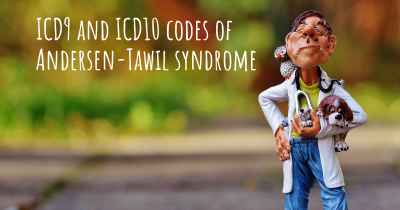What is the life expectancy of someone with Andersen-Tawil syndrome?
Life expectancy of people with Andersen-Tawil syndrome and recent progresses and researches in Andersen-Tawil syndrome

Andersen-Tawil syndrome is a rare genetic disorder that affects multiple systems in the body. It is characterized by a triad of symptoms including periodic paralysis, cardiac arrhythmias, and distinct facial features. The life expectancy of individuals with Andersen-Tawil syndrome can vary widely depending on the severity of their symptoms and the management of their condition. While some individuals may have a normal lifespan with proper medical care and treatment, others may experience complications that can impact their longevity. It is important for individuals with Andersen-Tawil syndrome to work closely with healthcare professionals to monitor and manage their symptoms to optimize their quality of life and overall health.
Andersen-Tawil syndrome (ATS) is a rare genetic disorder that affects multiple systems in the body. It is characterized by a triad of symptoms including periodic paralysis, cardiac arrhythmias, and distinct facial features. ATS is caused by mutations in the KCNJ2 gene, which plays a crucial role in the regulation of potassium channels in the heart and skeletal muscles.
Life expectancy in individuals with Andersen-Tawil syndrome can vary significantly depending on various factors such as the severity of symptoms, the presence of cardiac complications, and the overall management of the condition. It is important to note that ATS is a chronic condition that requires ongoing medical care and monitoring.
Cardiac arrhythmias are a major concern in ATS and can pose significant risks to affected individuals. These abnormal heart rhythms can lead to fainting spells, palpitations, and in severe cases, sudden cardiac arrest. The severity and frequency of arrhythmias can vary among individuals, and appropriate management strategies such as medication, implantable devices, or surgical interventions may be required to control these cardiac abnormalities.
Periodic paralysis is another hallmark feature of ATS. It is characterized by episodes of muscle weakness or paralysis that can last from minutes to hours. These episodes can affect various muscle groups, including the limbs, face, and respiratory muscles. The frequency and severity of periodic paralysis episodes can vary among individuals, and they may be triggered by factors such as stress, exercise, or certain medications. Prompt recognition and management of these episodes are essential to prevent complications and ensure adequate respiratory function.
While ATS can significantly impact the quality of life and pose potential risks, it is important to note that with appropriate medical management and lifestyle modifications, individuals with ATS can lead fulfilling lives. Regular follow-up with a multidisciplinary team of healthcare professionals, including cardiologists, neurologists, and geneticists, is crucial to monitor and address the various aspects of the syndrome.
Early diagnosis and intervention are key in managing ATS. Genetic testing can confirm the presence of KCNJ2 gene mutations, aiding in accurate diagnosis and enabling appropriate management strategies. Treatment approaches may include medications to control arrhythmias, prevent paralysis episodes, and manage associated symptoms. Lifestyle modifications such as avoiding triggers, maintaining a healthy diet, and regular exercise under medical supervision can also play a significant role in managing the condition.
It is important to emphasize that the prognosis for individuals with ATS can vary widely. Some individuals may experience milder symptoms and have a relatively normal life expectancy, while others with more severe cardiac complications or respiratory involvement may face greater challenges. Regular monitoring, adherence to treatment plans, and a supportive healthcare team are essential in optimizing outcomes and improving the overall prognosis.
In conclusion, the life expectancy of individuals with Andersen-Tawil syndrome is influenced by various factors, including the severity of symptoms, cardiac complications, and the overall management of the condition. While ATS is a chronic disorder that requires ongoing medical care, appropriate interventions, and lifestyle modifications, individuals with ATS can lead fulfilling lives with the support of a multidisciplinary healthcare team.








